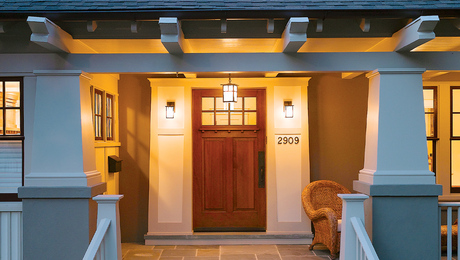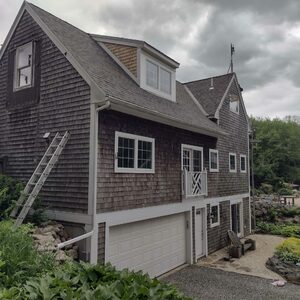New Garage-What length studs for walls?
Need some advise from some pro’s, I am building a 24 x 22 detached garage. Foundation is poured (no sill walls) I will be using 2- 2 x 6 sill plates and 2-2 x 4 top plates. I would like to use a single 16 x 7 door with a 2 x 12 header. What are the pros and cons of using a 8- foot stud or a 9 foot stud etc.? With a 8 foot stud would I have to cut an extra strip of sheathing for the walls. This is going to be my first major framing project so any advise is welcomed , thanks-Paul



















Replies
I like any extra height in a garage. You may possibly want a taller garage door if you think a high profile vehicle is in your future.
Taller is better. I'd go 10' if I had a choice.
A: A shopping cart has a mind of its own.
What Mark and Boss said.
I'd have a minimum of 9" height, 10' would be even better.
And an 8' door would be a must for me- my van (with racks on) won't fit under a 7' door.
Are you sure a 2x12 header is gonna work OK with a 16' clear span?
For a 7' door, full 8' studs would be the bare minimum just to make sure you have enough room for your door and opener. Personally, I'd go with an 8' door and 10' studs (as long as it's your money :-)) That's what I did with my money ;-)
Paul,
Dont know what you are building the garage for, but if you are a car hobbyist, you might want to think about some type of truss arrangement that will leave you enough height for a lift if you ever decide you need one. Wish I had done it when I built mine.
Bill Koustenis
Advanced Automotive Machine
Waldorf Md
If your going to do any woodworking in the garage I'd suggest 9' or better yet, 10' ceilings.
A real pain in the azz to spin a 4 X 8 sheet of ply in a 8' high garage!
Doug
What stand out in your post the most, if I understand you correctly, is the idea of using a 2”x12” header for a 16’ wide span. The minimum you will need is a 4”x14” (grade 1 douglass fir) garage door header. This type of header is commonly used for a 16’ span.
When you say there are “no sill walls,” I’m guessing this means there are no foundation walls or footers raised above the slab. If this is the case, I think I would only sheath down to the top of the first bottom plate. This would leave a 1 ½” gap from the bottom of the sheathing to the concrete. That’ll keep your sheathing dry. The first bottom plate you put down will, of course, be treated. This would also allow you to stand up full sheets of plywood or OSB if you used 8’ precuts. However, I would encourage you to use 9’ precuts, and cut 8’ sheets into 1’ pieces for the top. It’s a little work for a large investment.
One final thought. It’s not a good idea to have wood so close to the dirt that insects call home, even if it’s treated. Since you don’t have a raised footer, I would surround the garage with a perimeter of gravel.
-T
9' studs at a minimum, or even better, an exposed course or two of block and then tall studs. I built my first garage with 8' walls, and it was quite frustrating to work in. I built the next one with a 12' ceiling.
LVLs over the garage door opening, and 18x9 doors if you can make them look good on your garage, especially if any teenage or other-challenged drivers will be using the doors...
Be certain to leave some ceiling height for the garage door openers.
Thanks for all the replys, now you got me thinking of either 9 or 10 foot studs,with 2 sill plates and 2 top plates would make my wall height 9-6" or 10-6 ". Just a little concerned about total height of garage. With a width of 22 feet and plans for a 12/6 pitch that put me at the 17-foot mark. Brian could you explain what LVLs are? Plans call for 2- 2x12's with 1/2" plywood sandwiched for the header,this is for a 16-foot door. What would be a better choice? Thanks again all.
Here is an explaination of LVL's. If your spanning that far, spend a little extra and get the LVLs. They'll also be straight, no cupping, etc.
http://www.ilevel.com/literature/2015.pdf
http://www.trusjoist.com/EngSite/literature/index.cfm?#search
I also agree with the higher ceiling heights, I personally like 10'. Also, check with some garage door companies about their experiences with the door you want to use, they might give you more info about what would be best for your situation. The best steel door is Garaga.
LVLs are probably only necessary if the trusses bear on the wall over the door. If they don't, it may not be any big deal.
If toast always lands butter-side down, and cats always land on their feet, what happen if you strap toast on the back of a cat and drop it?
Others have replied on the LVL, so I won't belabor...but my local Lowes carries 18' LVLs in stock - I have a habit of overbuilding things b/c when I don't I regret it, and sometimes go back and overbuild anyway - I did exactly this once on a 16' span over a garage opening like yours. If BossHog says 2x12s are OK, then they are - he designs trusses every day.
Tall garages are great inside, but can look goofy outside - make a few drawings and be certain you aren't overwhelming other structures or building a silo.
Treat every person you meet like you will know them the rest of your life - you just might!
2 sill plates and 2 top plates would make my wall height 9-6" or 10-6 ".
Your inexperience is showing. No offense. Glad to help. : - )
Yes, using uncut 9' or 10' 2 x 4s, but wall studs are precut to accurate dimensions.
Common 2 x 4 lumber is not necessarily an accurate and consistant length dimension.
Use pre-cut studs for whatever wall height you use.
Avaliable and common stud lengths for 8' / 9' / 10' walls are as follows:
8' - 92 5/8" / framed wall height 97 1/8"
9' - 104 5/8" / framed wall height 109 1/8"
10' - 116 5/8" / framed wall height 121 1/8"
Using a double sill plate would provide an additional 1 1/2" framed wall height.
The framed wall height listed above using pre-cut studs is technically accurate, given absolute and perfectly tight construction, but the insignificant connection gap of stud to plates and the unavoidable and insignificant gap between plates usually adds 1/4" plus or minus.
Thanks for the info txlandlord- like I said this is all new to me but I,m a quick learner and any info is welcomed. I asked my local lumber store if he carried 9- foot pre-cuts and he did not. Could you explain what is the basis for using a pre-cut stud.Is it for sheathing, etc. thanks
My attached garage is roughly those dimensions. I just finished reframing the roof, and I raised the walls from 7'6" to 8"6" - made a big difference. I didn't need a taller door, I needed storage space over the door. I wish I could have raised it more, but I could not with how my house is laid out.
Rebuilding my home in Cypress, CA
Also a CRX fanatic!
I would trade the extra strip of sheathing for cieling height any day
Of course all this depends on what you plan to do with the garage. another factor might be the size of your house, you dont want to grandstand the garage over the house
Where do you live? If you have a Bubba truck then it won't fit with less than 10 foot lid.
Hmm, is the garage door going in the long wall or the short one?
If you go with taller walls (a generally good thing), talk to your overhead door supplier--with the taller walls, an 8' door can look better (sometimes).
Is your plan to have a flat ceiling, or to jsut expose the roof structure?
If you go "open," and the door is not in a/the gable wall, talk to the o/h door guy about having the door "follow" the roof angle. This is not a very common thing to do, but it sure helps cut down on that great big shadow the open door makes with the lights on.
Now, I happen to like having a "matching" o/h door on detached garages on the "other" wall. Beyond just being darn convenient, it also can provide a lot of access for projects, or just for ventilation. (Really nice to open that "other" door and use a table saw where it sits, rather than back the ride out, move the saw, etc.)
I'm not sure what you mean by "no sill walls". If that means your plan is to set the wood framed walls on the concrete slab, that is a really bad idea for several reasons.
First, water and snow that drips off of your car will run across the floor and soak the sill plates. It will also soak your interior wallboard if you have any. Second, unless your slab is unusually high and you have a ramp at the doorway the siding will be too close to the ground. Water will splash on it, and under the bottom lip. Also, the air near the ground is more damp than a foot or so above. Snow will pile up against it. Third, water will wick from the slab into the sill plate. If it were elevated on sill walls the amount of wicking is reduced.
Before you frame you should put at least one course of concrete block around the perimeter (except where the doors go, of course). The sill plates need to be anchored to the slab, not just to the perimeter block. And only a single sill plate is needed. Plastic roll flashing or sill seal should be put under the sill plate as a capillary break.
People here are very willing to help with advice, but something about your job scares me. When people don't plan out the basics of a job before they begin, and just make it up as they go along, they generally get poorer results. You poured a slab without knowing where you are going next. If you keep doing this for the whole project you are likely to have to backtrack and re-do something correctly or end up with something that is not right. You are taking a risk by not planning.
In any case back to your question, 8' walls are somewhat short for a garage. The headroom provided by taller studs makes installing garage doors and openers easier, and provides more height for hanging up garden tools and other items. It also feels better to not have the ceilings so low in a room with fairly wide dimensions. A 16' wide door is narrow if you plan on having two vehicles. Eighteen foot is more common.
Edited for spelling.
Edited 6/4/2006 10:36 pm ET by WayneL5
Just to add to a couple of points already mentioned. I just rebuilt my garage and already had 2 courses of CMU to build on (if not I would have added them for the same reason mentioned above). I was building to a specific height to pick up on other parts of the structure so I cut my studs to a specific length, but I did achieve an 11'+ ceiling height with a 9' high garage door. I work on my car and it is an adhoc shop as well, so the extra height is really desireable. My garage roof is flat, so that the structure was not out of scale with the rest of the house.
I also put in windows, skylights and plenty of outlets.